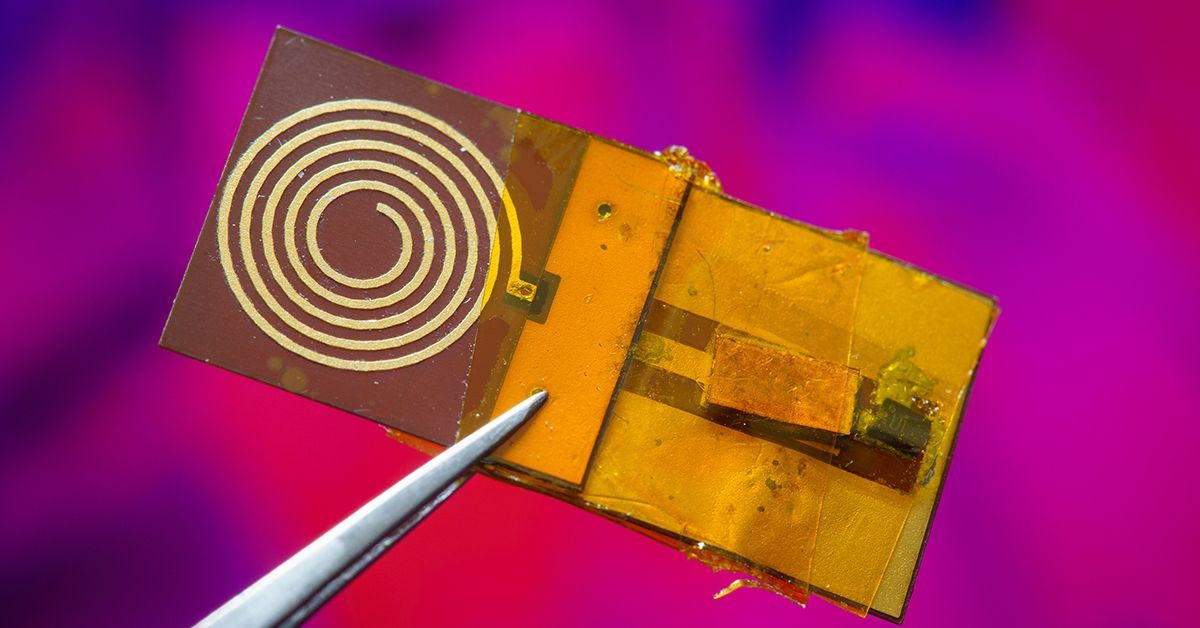Wireless, Battery-free Electronic ‘Stickers’ Gauge Forces Between Touching Objects
Story by:
Published Date
Story by:
Topics covered:
Share This:
Article Content
Engineers at the University of California San Diego have developed electronic “stickers” that measure the force exerted by one object upon another. The force stickers are wireless, run without batteries and fit in tight spaces. That makes them versatile for a wide range of applications, from arming robots with a sense of touch to elevating the immersive experience of VR and AR, making biomedical devices smarter, monitoring the safety of industrial equipment, and improving the accuracy and efficiency of inventory management in warehouses.
They could be used, for example, in knee implants to measure the forces that implants exert on the joint. Having the ability to sense changes in these forces can be useful for monitoring an implant’s fit, as well as wear and tear. Force stickers could also be placed on the bottom of warehouse packages to measure the weight of their contents, acting as miniature scales for checking inventory.
“These force stickers could make technology more intelligent, interactive and intuitive,” said Dinesh Bharadia, professor of electrical and computer engineering at the UC San Diego Jacobs School of Engineering. “Humans, by nature, possess an inherent ability to sense force. This allows us to interact seamlessly with our surroundings and enables clinicians to perform delicate surgical procedures. Providing this force-sensing ability to electronic devices and medical implants could be a game-changer for many industries.”
A team led by Bharadia will present the new force stickers at the UbiComp 2023 conference, which will take place from Oct. 8 to 12 in Cancun, Mexico.
The force stickers consists of two main components. One is a tiny capacitor that is just a few millimeters thin and about the size of a grain of rice. The other component is a radiofrequency identification (RFID) sticker, which is a device that functions like a barcode that can be read wirelessly using radio signals. The researchers found a clever way to integrate these two components together so that they can measure the force applied by an object and communicate that information wirelessly to an RFID reader.
The capacitor is made of a soft polymer sheet sandwiched between two conductive copper strips. When an external force is applied, the polymer compresses, drawing the copper strips closer together, thereby increasing the electric charge in the capacitor.

This increase in electric charge as a result of applied force is key, the researchers show, because it creates changes in the signal transmitted by the RFID sticker. An RFID reader remotely measures these changes and translates them into a specific magnitude of applied force. This particular technique of creating changes in RFID signal enables the components within the force sticker to be miniaturized. In comparison, previous methods to create changes in RFID signal required components that are a thousand times larger in size.
Meanwhile, the RFID sticker runs on extremely low power by transmitting radio signals via a technique called backscattering. It takes incoming radio signals from an RFID reader, modifies the signals via electric changes induced by the capacitor, and then reflects the modified signals back to the reader, which deciphers and translates them into applied force.
As a result, the force sticker runs on essentially no power. “The design is really simple with minimal electronics,” said study first author Agrim Gupta, an electrical and computer engineering Ph.D. student in Bharadia’s lab.
Another design feature is that the capacitor can be customized for various force ranges. By replacing the polymer layer with a softer or stiffer one, the capacitor can be tailored to measure smaller or larger forces, respectively.
To demonstrate, the researchers built and tested two types of force stickers. In one sticker, the capacitor was built with a super soft polymer to measure smaller forces, making it suitable for use in experiments in a model knee joint. Placed within the joint, the force sticker accurately measured different applied forces as the researchers pushed on the joint. The second sticker, in which the capacitor was constructed with a stiffer polymer, was tested in a warehouse packaging experiment. Attached to the underside of a box, it accurately measured the weight of varying quantities of objects placed in the box.
In tests, the force stickers were extremely durable. They withstood more than 10,000 force applications and remained consistently accurate. Additionally, they can be fabricated at low cost, with each sticker amounting to less than $2, the researchers noted.
“If we can commercialize this technology, we imagine that in the future a box of them could be sold inexpensively, like a box of Band-Aids,” said Gupta.
However, it is worth noting a limitation: these force stickers require a static environment to function effectively and do not perform optimally in highly dynamic surroundings. The researchers are actively addressing this issue as they seek to further improve the technology.
Moving forward, the researchers aim to make the force stickers readable by smartphones, which would eliminate the need for RFID readers.
Paper: “ForceSticker: Wireless, Batteryless, Thin & Flexible Force Sensors.” Co-authors include Daegue Park, Shayun Bashar, Cedric Girerd, Nagarjun Bhat, Siddhi Mundhra and Tania K. Morimoto, UC San Diego.
Medium Blog: https://medium.com/p/796294399c91/edit
This work was supported in part by the National Science Foundation (grant 1935329).

You May Also Like
Stay in the Know
Keep up with all the latest from UC San Diego. Subscribe to the newsletter today.




